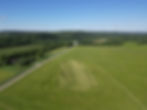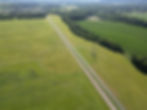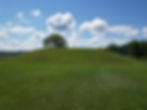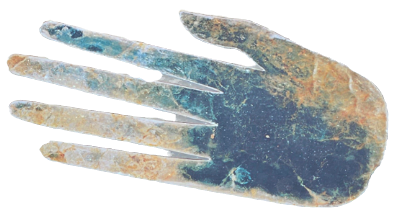Exploring Ohio's Hopewell Culture National Historical Park: A UNESCO World Heritage Site
- Dan Wagner
- Aug 5, 2023
- 18 min read
Updated: Feb 8, 2024
More than two millennia ago, long before the first Europeans ever set foot on the continent, Native Americans built thousands of ceremonial mounds and earthen enclosures in present day southern Ohio. These mounds served as places for rituals, feasts, funerals, and rites of passage to a thriving culture known as the Hopewell. For nearly six centuries, the Hopewell created massive earthwork complexes, ranging from tens to hundreds of acres, thereby imprinting their distinctive legacy on the landscape for millennia to come. Today, Hopewell Culture National Historic Park safeguards and conserves the prehistoric signatures of the Hopewell through five unique sites: Mound City Group, Hopewell Mound Group, Seip Earthworks, Hopeton Earthworks, and High Bank Works. All but High Bank Works are open to the public. On September 19, 2023, the UNESCO World Heritage List welcomed the inclusion of these five sites, together with Fort Ancient Earthworks and Newark Earthworks, collectively recognized as Hopewell Ceremonial Earthworks.

A Brief History of the Hopewell Culture
Before visiting Hopewell Culture National Historical Park, it is helpful to familiarize yourself with the identity of the Hopewell people, their customs, and the historical significance that surrounds them.
The Hopewell culture was not a single tribe, rather a vast network of prehistoric Native American societies that thrived in parts of eastern North America from 100 BC to 500 AD, during what is known as the Middle Woodland period. The primarily hunter-gatherer civilization was renowned for its extensive trade networks, sophisticated artistry, and large-scale earthworks. They were primarily centered in the region around the Ohio River Valley, but had a widespread influence across a vast area that included parts of present-day Illinois, Indiana, Kentucky, Michigan, Wisconsin, and as far south as the Gulf Coast and Florida.
Well-known for their expansive trade networks covering thousands of miles, the Hopewell engaged in the exchange of precious resources like copper, mica, shells, obsidian and other exotic materials across far-reaching distances. Archaeological evidence confirms this, as artifacts like obsidian spearheads from Wyoming and various copper items from Lake Superior have been unearthed at archaeological sites in southern Ohio.
The legacy of the Hopewell culture is best exemplified by its monumental earthworks and predominantly conical shaped mounds, which served various purposes as burial sites, ceremonial centers, and markers for celestial events. Their architectural achievements were awe-inspiring, with many of the structures ranking among the largest non-fortification or defensive structures in the world. For perspective, a single Hopewell earthwork could contain the Great Pyramid of Giza, once the largest man-made structure in the world, and another could accommodate four structures the size of the Colosseum of Rome.
The Hopewell demonstrated remarkable proficiency in mathematics. Early archaeological studies have revealed compelling evidence that multiple earthworks exhibit striking similarities in their measurements. Notably, the enclosure walls of five square-shaped earthworks, scattered across southern Ohio and located dozens of miles apart, all precisely measure 1,080 feet in length. Additionally, at three other sites, evidence points to nearly perfect circle enclosure walls, each measuring exactly 1,054 feet in diameter, further exemplifying their advanced mathematical knowledge.
Their expertise extended beyond geometry, as they showcased a sophisticated understanding of astronomy within their earthworks. A prime illustration of this can be found in the octagon and circle combinations at two distinct complexes. These earthworks feature precise alignments to key points on the horizon where the moon rises and sets during its 18.6-year-long cycle. The discovery of this celestial cycle indicates that Hopewell sky-watchers engaged in systematic observations of the moon for several generations, demonstrating their profound knowledge and dedication to studying the cosmos.
Around 500 AD, the Hopewell culture experienced a notable decline, marked by the cessation of trade, earthwork, and mound construction, as well as the discontinuation of their characteristic art forms. The specific reasons behind this decline remain a mystery, but archaeologists have explored possibilities such as changes in trade patterns, shifts in the environment, and social transformations as potential contributing factors.
What the Hopewell called themselves and what language they spoke is unknown. Like many ancient civilizations, evidence of their written language, if in fact there was one, has yet to be discovered. Similar to many newly unearthed civilizations, the Hopewell culture got its name from the location where its artifacts were first discovered. Therefore, it was named after the field, once owned by Mordecai Cloud Hopewell in the 1800s, where the first evidence of their ancient culture was found and where the Hopewell Mound Group stands today.
Map of Hopewell Culture National Historical Park Sites

Mound City Group
16062 OH-104
Chillicothe, Ohio
Mound City Group is one of the most remarkable Hopewell sites within Hopewell Culture National Historical Park. The vast complex, covering nearly 17 acres, comprises 23 mounds of diverse shapes and sizes, enclosed by a low, earthen wall. It stands as the largest concentration of ancient Hopewell mounds found anywhere in North America today. Interestingly, despite its name, Mound City was not a city but rather a village and mortuary site that served the Hopewell living along the Scioto River during the first two centuries AD.

Upon arriving at the site, a well-laid paved path guides visitors from the visitor center towards a gateway within the earthen enclosure wall. Just prior to reaching the enclosure wall, visitors will encounter two large depressions in the ground, one on each side of the paved path. These depressions constitute just two of the many borrow pits discovered at the site, where the Hopewell excavated earth to construct the earthworks of the site. Once within the enclosure wall, amid the impressive mounds at the forefront of the complex, Mounds 13 and 8 stand out as particularly notable.

During the excavation of Mound 13 in 1921, archaeologists made a remarkable discovery: the cremated remains of twenty Hopewell individuals, the largest number found among all the mounds within the complex. However, what truly astonished them was the unearthing of a raised rectangular grave adorned with sheets of mica believed to have been sourced from the mountains of North Carolina and offered as precious gifts or offerings at the site.
Upon closer examination, four more burials were found atop the sheets of mica, indicating that these individuals held esteemed positions with Hopewell society. The Hopewell people greatly valued mica, using it extensively in their ceremonial practices, crafting mirrors, and creating various ornamental items, and the discovery shed new light on the significance of mica within their culture and religious practices.
Apart from these extensive findings, a remarkable collection of artifacts was uncovered during the excavation. These included elk and bear teeth, intricate copper ornaments, large obsidian projectile points, a cache of 5,000 shell beads, and effigy pipes depicting a raven and a toad. Additionally, two copper headdresses were discovered - one adorned with three pairs of copper antlers, and the other fashioned to resemble a bear, complete with hinged ears and legs riveted on.

The excavation of Mound 8 led to the unearthing of some of the most significant discoveries within the Mound City Group complex. Within the mound, a remarkable collection of nearly 200 intricately carved stone effigy pipes were unearthed, offering invaluable insights into the hairstyles, headdresses, and facial tattooing practices of the Hopewell people. Pipes depicting various animals were also unearthed, including representations of panthers, bears, wolves, beavers, turtles, toads, frogs, and rattlesnakes. Like many other Native American cultures, the Hopewell believed smoke to be a form of communication with the spirit world. It is plausible that Mound 8 served as a monument dedicated to a master pipe carver.

Further into the complex, two other significant mounds, Mounds 3 and 7, present themselves. Mound 7 (in the foreground below), often referred to as Central Mound or Death Mask Mound, stands as the largest and oldest among the Mound City Group. Its 1920s excavation proved to be a breakthrough for archaeologists, offering them an unmatched comprehension of the construction techniques employed in Hopewell mounds.

Upon careful examination, archaeologists discovered that the process of constructing these mounds was much more intricate and sophisticated than a simple act of piling up dirt. The mounds were composed of a complex sequence of clay, sand, and gravel. The construction process began with a foundation of molded clay topped with sand, creating the initial layer that covered a central grave. Following this, three more layers of clay were meticulously laid, each separated by sand, measuring precisely one foot in thickness. The final stage involved several feet of clay, crowned with a twenty-inch layer of gravel, adding to the mound's stability and durability. It should be highlighted that the enclosure wall surrounding the perimeter of the Mound City Group was the last structure built by the Hopewell at this site. Once the enclosure wall was constructed, no more mounds were built.

Apart from shedding light on the construction methods employed by the Hopewell, thirteen cremated burials and an abundance of exquisitely crafted copper figures were unearthed from Mound 7. Among the most magnificent of the artifacts unearthed was a large copper falcon featuring exquisite detail and an ornate copper breastplate, worn for protection from arrows and spears. Notably, the copper used for the artifacts originated from nearly 600 miles away, near Lake Superior, emphasizing the extensive trade networks and artistic connections of the Hopewell.
Another fascinating artifact unearthed at Mound 7 was the "Mushroom Wand." This intriguing piece, an effigy of a death-cap toadstool measuring 13-1/2" in length, consisted of copper-covered wood and was found alongside the cremated remains of a Hopewell individual. Archaeologists believe that this artifact symbolizes a hallucinogenic mushroom, likely used in shamanistic rituals by the ancient Hopewell people.

The copper plate shown below was also unearthed from Mound 7 and stands out for its exceptional rarity and composition. Not only does it belong to a select group of roughly 200 copper plates worldwide, but it also possesses a distinctive feature - it is a composite artifact, consisting of a fascinating amalgamation of at least three distinct materials preserved in copper salts: dark fur adorning one side, a section of cut leather, and feathers, possibly derived from an entire bird's wing.

Perhaps the most remarkable artifact unearthed from Mound 7 remained unrealized for over three decades after its initial discovery. During the excavation in the 1920s, alongside one of the thirteen burials, archaeologists found fragmented human skull remains that had been burned. However, it wasn't until the 1950s, when Dr Raymond Baby of the Ohio State Museum meticulously placed the fragments together, that the true nature of the discovery was revealed. Astonishingly, the fragments formed a mask explicitly designed to fit over a shaman's face. The mask's significance was further enhanced by holes drilled along its lower margin, indicating that ornamental attachments and/or a cloth or leather hood might have adorned the mask in the past. It is believed that the shaman who wore the mask could have personified death during shamanistic rituals, hence the mound's nickname, Death Mask Mound. Currently, the cranial remains are held by the Hopewell Culture National Historical Park; however, they are not currently being exhibited. Back in 1954, the Papers in Archaeology journal by the Ohio History Connection featured an article where the Curator of Archaeology at the time, Dr Baby, shared his discoveries and provided an interpretation of the possible appearance of the mask.

Today, the name Death Mask Mound has been entirely expunged from the park's literature and displays, replaced simply with Mound 7. However, references to the mound's former name can be found in local newspapers throughout the 1970s.

Mound 3, also known as Elliptical Mound, is positioned between Mound 7 and another, smaller conical mound, and hints at a possible connection among the three structures. Despite its substantial size, stretching 140 feet in length, Mound 3 yielded only four burials during its excavation. One of these burials was particularly intriguing, surrounded by an impressive array of several hundred broken flint spearheads showcasing unique forms and exceptional craftsmanship. Perhaps the most remarkable spearhead discovered in the mound was an obsidian spearhead, which originated from the Yellowstone region, an astounding 1,400 miles away. Also found within Mound 3 were fossilized shark teeth and horn corals, and 8,000-year-old mastodon tusk fragments.

Three intensively used crematory basins uncovered on the mound floor indicate that many cremations were performed near Mound 3. Additionally, a wealth of artifacts was found in one of the basins, including stone tools, pottery, copper objects, shell beads, and two platform pipes, underlining the richness of the cultural materials associated with the mound.
An interesting note regarding the cremation practices of the Hopewell is that they would dismember the bodies of the deceased prior to the cremation ritual. This involved removing the head, lower legs, and potentially even the entire torso. The sequence of their burial procedure seemed to have involved several stages: first, the deceased individual's body was transported to a sacred structure where the dismemberment took place. Following this, the disarticulated segments and torso were placed in clay basins and cremated. The calcined remains were then laid to rest on the floor of the burial mound, enclosed by stone or log tomb.

The site of each mound within the Mound City Group complex was originally occupied by a wooden structure, likely a mortuary temple, used to administer the last rights of the deceased. Once a certain time had passed, these structures were deliberately set on fire, perhaps to purify or release the spirits of the departed into the spirit world. Among all the mound sites in the Mound City Group, Mound 15 remains unreconstructed, revealing the floor plan of one of these ancient structures.
Located at the front of the complex, the Hopewell Culture National Historical Park Visitor Center provides visitors with the chance to engage with one of the park's knowledgeable rangers, view Hopewell artifacts, and watch a 20-minute park orientation film highlighting the Hopewell culture and its incredible achievements. The park also offers free ranger guided tours, which come highly recommended and require no prior reservation.

In June 1917, the United States War Department took possession of the Mound City Group complex and constructed Camp Sherman, a military training ground for World War I. Five thousand men raced to complete construction in less than three months, erecting a building every 20 minutes. In total, 2,000 buildings were constructed. Sadly, all but the largest mound (Mound 7) were either damaged or obliterated during Camp Sherman's construction.
In the early 1920s after the camp was taken down, the Ohio Historical Society excavated the site and began reconstructing the mounds. In 1923, during President Calvin Coolidge's tenure, Mound City was designated as Mound City Group National Monument. Ultimately, in 1992, Mound City Group National Monument, along with Hopewell Mound Group, Seip Earthworks, Hopeton Earthworks, and High Bank Works, merged to form Hopewell Culture National Historical Park. Today, Mound City stands as the sole fully restored Hopewell culture site in North America.
Hopewell Mound Group
4731 Sulphur Lick Rd
Chillicothe, Ohio
Among the remarkable prehistoric earthworks in southern Ohio, the Hopewell Mound Group stands out in several aspects. Notably, it features the most impressive single earthen-walled enclosure ever constructed by the Hopewell, encircling an expansive 116 acres. Within the enclosure lies 29 mounds, including the largest mound ever built by the Hopewell, Mound 25. Moreover, a treasure trove of unparalleled proportions has been unearthed at the complex, revealing an astonishing collection of artistic Hopewell objects of the highest caliber.
Among the most iconic items discovered at the Hopewell Mound Group are a mica bird claw, a copper bear claw, a large mica hand with elongated fingers, a partial mica human body, a large copper facial representation, a large copper bird similar to one unearthed at Mound City Group, numerous copper antler headdresses, and a vast number of gigantic ceremonial blades crafted from obsidian originating from the Yellowstone region. The vast amount of obsidian found at the site marked a significant milestone - the largest ever discovered east of the Mississippi River.
A visit to the Hopewell Mound Group begins with a brief stroll leading to a viewpoint that offers a panoramic view of a vast open field. At first glance, the view is rather unimpressive. While two placards at the viewpoint provide information about the complex's discoveries, viewing the earthworks from this distance can prove challenging. To truly appreciate the site, it is highly recommended setting off on the 2.5-mile interpretive hiking trail, which starts from the viewpoint. The trail follows a wooded ridge, adorned with numerous informative placards that delve into the fascinating lives of the Hopewell people. As you emerge from the forest, the path winds through the open field, passing alongside numerous earthworks.

The first significant archaeological site that you'll encounter is Mound 25, the largest Hopewell mound ever discovered. Originally towering more than 30-feet in height and stretching more than 500-feet in length, Mound 25 was an impressive feat, requiring an estimated one and a half million basket loads of earth, all painstakingly carried by hand during its construction. Such a monumental endeavor would have spanned multiple generations for the Hopewell to complete. However, the mound's grandeur faced challenges over time. In the 1800s and 1900s, archaeologists excavated the site, looters disturbed it, and farming activities diminished its size, leaving it at a modest height of no more than eight feet today.

During the excavations of Mound 25, archaeologists unearthed remarkable artifacts. Notably, they discovered two substantial deposits of copper objects, including dozens of intricately crafted copper sheet ornaments, large copper axes, numerous adzes, and ornate cutouts, which provided valuable insights into the Hopewell's craftsmanship and material culture.
The base of the mound revealed more treasures, such as fire pits, post holes, an impression of a basket used for hauling earth, and multiple grave sites, all adding future depth to our understanding of the ancient civilization that once thrived here.

The article below, published on November 25, 1891, in the Butler Weekly Times, details Warren King Moorehead's excavations of Mound 25 in 1891. It highlights the discovery of two skeletons, notably a male skeleton encased in copper armor.

The following article, published by the Chillicothe Gazette on February 17, 1897, discusses more artifacts unearthed from Mound 25 during the 1890s. At the center of the article are two copper swastikas, symbols with global historical roots predating their association with German Nazis, discovered within the mound.

For nearly two centuries, Mound 25 was thought to consist of three separate conical burial mounds. However, a recent groundbreaking archaeological survey conducted by a German university revealed a stunning revelation. Upon close examination, it was discovered that what was previously considered three mounds was, in fact, a single massive effigy mound. An effigy mound is a raised earth structure designed in the shape of an animal, human, or other figure. This remarkable find prompted the national park to begin mowing around the mound to showcase the newfound discovery.

The significance of the discovery goes beyond the mere reshaping of the landscape. It challenges the long-held belief that the Fort Ancient peoples, who followed the Hopewell chronologically, were the earliest effigy mound builders in the region. The effigy mound predates even the world renowned Serpent Mound, constructed by the Fort Ancient in nearby Peebles, Ohio, and thus forces a complete reevaluation of the archaeological history in the area.
Located to the north of the effigy mound, the mowed trail passes alongside three low-lying burial mounds, each measuring between ten and thirty feet in diameter.

Among these mounds, Mound 2 (on the right) proved to be of particular significance when, in the early 1900s, an astounding discovery was made. Within the mound, archaeologists uncovered a vast cache of over 8,000 flint disks, crafted from Wyandotte chert sourced from Indiana. One prevailing theory speculates that they may have been offerings brought by visitors from outside of the area, bestowing their gifts upon the Hopewell. However, as with many archaeological findings, the true reason for their presence might forever elude us, leaving us to wonder and speculate about their significance.

On February 24, 1924, the Chillicothe Gazette circulated an article detailing the discovery of numerous burials within the smaller mounds at Hopewell Mound Group. Among the findings was a burial containing an intricate sarcophagus-style stone grave, within which rested a toothless skeleton surrounded by grave goods indicative of a high societal status.

Continuing along the trail, you'll come across the remnants of yet another expansive ceremonial site known as the Great Circle. Unlike a traditional mound, this site is thought to have served as a significant gathering place, possibly for ritualistic performances.

In 2014, archaeologists conducted a survey of the Great Circle utilizing a magnetometer to identify irregularities in the soil. The examination unveiled a trench encircling the Great Circle, coupled with the presence of 108 dots along its perimeter. The discovery prompted archaeologists to speculate that a wooden structure, approximately 375 feet in diameter known as a woodhenge, could have been erected and subsequently disassembled at the location.

From the Great Circle, the path returns to the trailhead.
It's worth noting that although many Hopewell complexes had relatively short periods of use, the Hopewell Mound Group defied the trend. Evidence strongly indicates that this site maintained its significance as a vital ceremonial center throughout the entire Hopewell era, spanning an impressive four to five hundred years.
Seip Earthworks
7058 US-50
Bainbridge, Ohio
Located fifteen miles southwest of Chillicothe, the Seip Earthworks, pronounced "Sipe," represents one of the Hopewell's most marvelous engineering achievements. When the complex was constructed nearly two millennia ago, over two miles of earthen wall embankment enclosed over 120 acres of land, including an irregular circle enclosure spanning more than 1600-feet in diameter, a smaller circular enclosure of nearly 1000-feet, and precisely crafted square enclosure, also measuring nearly 1000-feet. The construction of these enclosures and numerous burial mounds, including Seip Mound, the second-largest Hopewell mound ever discovered, likely spanned several generations.

Seip Mound, measuring an impressive 240 feet in length, 160 feet in width, and standing 30 feet tall, underwent a gradual evolution that began nearly 2,000 years ago. It all started with the construction of an oblong, multi-room mortuary structure. Within this building, ceremonial leaders carried out the cremation of bodies at a separate location and then interred the ashes in the mortuary. After the burial rituals were completed, the mortuary building was intentionally set ablaze, and the construction of the mound commenced. Layer upon layer, the mound took shape, preserving the significance and memory of those laid to rest within it.

Today, among all the mounds that once graced the Seip Earthworks complex, only Seip Mound remains. Regretfully, nearly thirty mounds succumbed to farming practices and were levelled over the past century and a half. Nevertheless, Seip Mound stands as a remarkable testament to the past, though it is a full reconstructed mound. Early excavations nearly obliterated its existence, but dedicated restoration efforts successfully recreated its original dimensions, preserving its historical significance.

Seip Mound served as the final resting place for a significant number of Hopewell, totalling at least 122 men, women, and children. The graves were accompanied by a fascinating array of unusual objects that surrounded the remains. Excavations have yielded an extraordinary collection of artifacts, each bearing its own historical and cultural significance.
Among the findings were large effigy pipes, with one depicting a dog devouring a human head, showcasing the artistic prowess of the Hopewell people. A meticulously crafted clay sculpture of a Hopewell human head was also discovered, adding to the artistic richness of the burial site. Additionally, rare samples of intact Hopewell cloth, featuring intricate patterns of circles and curves reminiscent of Hopewell earthworks, were unearthed, shedding light on their textile traditions.

The unearthing of thousands of freshwater pearls underscored the importance of these beautiful gemstones within the Hopewell culture. Found in a solitary burial site, subsequently named the "Pearl Burial," these pearls bestowed upon Paint Creek Valley the moniker "Valley of the Kings."
Furthermore, a wide array of ornaments crafted from copper, mica, tortoise shell, and silver added to the diversity and opulence of the burial offerings found within Seip Mound.


At the forefront of the complex, a short distance beyond the remnants of one of the enclosing walls that once embraced the site, lies the site of a former Hopewell wooden structure, clearly marked by numerous replica posts. In 1971, archaeologists made a significant discovery here, uncovering impressions of the original posts that likely composed the walls and roof of a workshop used during ritual preparations.

As excavations of the workshop progressed, an array of intriguing artifacts emerged. Among the findings were hundreds of mica fragments, flint knives, pottery sherds, and animal bones, all of which provided valuable clues about activities that took place in the ancient workshop.

Unique among the mounds within the national park, Seip Mound is the only one where climbing is permitted. By ascending to its top, visitors are rewarded with a panoramic view of the smaller circular enclosure that stood there millennia ago. Today, the National Park Service diligently maintains the practice of interpretive mowing, which outlines the earthworks, allowing visitors to envision and comprehend the remarkable structures that once graced the land.

Climbing to the top of the mound also affords an opportunity to view the massive square enclosure from an elevated vantage point. Evidently, the Seip Earthworks and similar complexes were not products of random earth-piling as prior stated; their geometric precision and symmetry indicate a deliberate design. In fact, the striking resemblance in design and dimensions among Seip Earthworks, along with four other complexes in Chillicothe - Baum, Frankfort, Works East, and Liberty Earthworks - strongly suggests that they were all engineered based on plans created by the same group of people.
Back in the 1840s, early American archaeologists meticulously mapped and measured these five earthwork complexes. Notably, each square enclosure in these sites shared the exact measurements of 1,080 feet on each side and an area of 27 acres. This remarkable consistency implies that the Hopewell had a standardization unit of measurement more than two millennia ago.

A brief interpretive trail leads to the square enclosure, but like the smaller circular enclosure, the square is best viewed from the top of the mound. Seip Mound was named after James Seip, a local landowner who donated a portion of his lands to the Ohio Historical Society in 1923. In 2014, Seip Earthworks was officially transferred from the Ohio Historical Society to the National Park Service.
Hopeton Earthworks
990 Hopetown Rd
Chillicothe, Ohio
At 292 acres, Hopeton Earthworks stands as one of the grandest Hopewell complexes ever built. Comprising of two immense geometric enclosures, the site features an 18-acre circle, aptly named the Great Circle, and a 19-acre square. Additionally, it features two smaller circular enclosures and two parallel walls that once stretched a remarkable 2,400 feet away from the larger enclosures.

Similar to numerous other Hopewell earthworks, the Hopeton Earthworks complex has not escaped the impact of agriculture. Presently, all of the earthworks and at least three burial mounds here have been eroded to less than five feet in height, with most significantly less, if not completely lost. However, during antiquity and even as recent as the 1840s, the earthen walls at Hopeton reached heights up to twelve feet and stretched more than fifty-feet wide. Like Seip Earthworks and Hopewell Mound Group, interpretive mowing is featured at this site, affording opportunities to visualize the Hopewell's monumental achievements.

The construction of the Hopeton Earthworks had a clear purpose, exemplified by the intentional alignment of a causeway formed by parallel walls with the sunset on the winter solstice. This demonstrates a clear understanding that the Hopewell had of celestial events. Due to agriculture and quarrying, these walls have been reduced in length from their original size, but remain clearly visible today.
Recent discoveries by National Park Service archaeologists reveal that a colossal "woodhenge" once encircled the expansive circular earthwork at Hopeton. To uncover this historical marvel, they employed a cutting-edge technology capable of peering beneath the ground's surface and generating a map that highlights areas where ancient peoples disturbed the soil through digging. Detected were a series of disturbances positioned at 20-foot intervals, tracing the inner edge of the Great Circle. Upon excavation, archaeologists unearthed a substantial pit housing the remnants of a massive timber post, estimated to be around two feet in diameter and towering 20 feet in height. The findings provide mounting evidence that at least the Great Circle was adorned with a monumental wooden structure, possibly of astronomical significance, adding a new dimension to our understanding of the Hopewell's history.


Visitors can experience the earthworks by strolling along a 0.6-mile mowed grass trail that leads to an overlook.

From the overlook, situated slightly above the surroundings, visitors can observe both the Great Circle and the large square enclosure, along with the parallel walled causeway.
A nice complement to a trip out to Hopewell Culture National Historical Park, is a visit to Leo Petroglyphs & Nature Preserve, located 30 minutes away near Ray, Ohio. There, you can view one of Ohio's most prominent Native American rock art sites, with more than thirty distinct Fort Ancient petroglyphs.
_edited.png)


























































